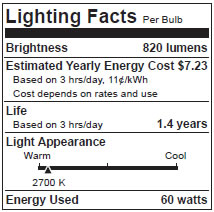- Thread starter
- #621
I wonder if this is ALL bulbs? or just flouros and incandescents?
Coming in 2011: New Labels for Light Bulb Packaging
Lumens and Kelvins, and NOT Watts!
Labels Will Emphasize Lumens, Not Watts, as a Measure of Bulb Brightness
Starting in mid-2011, the Federal Trade Commission announced today, consumers shopping for light bulbs will notice new labeling on packaging designed to help them choose among the different types of bulbs on the market – traditional incandescent bulbs, and newer high-efficiency compact fluorescent (CFL) and light-emitting diode (LED) bulbs. The new labels will enable consumers to save money by selecting the most efficient bulbs that best fit their lighting needs.
Under direction from Congress to re-examine the current labels, the FTC is announcing a final rule that will require the new labels on light bulb packages. For the first time, the label on the front of the package will emphasize the bulbs’ brightness as measured in lumens, rather than a measurement of watts. The new front-of-package labels also will include the estimated yearly energy cost for the particular type of bulb.
While watt measurements are familiar to consumers and have been featured on the front of light bulb packages for decades, watts are a measurement of energy use, not brightness. As a result, reliance on watt measurements alone make it difficult for consumers to compare traditional incandescent bulbs to more efficient bulbs, such as compact fluorescents. A compact fluorescent bulb may be able to produce the same amount of brightness as a traditional incandescent bulb, while using significantly less energy, or watts. New energy standards mandated by Congress will effectively phase out traditional low-efficiency incandescent bulbs from the U.S. market over the next few years. The new labels that focus on brightness in lumens will help consumers make purchasing decisions as they transition to more energy-efficient types of bulbs.
Under the new rule, the back of each package of light bulbs will have a “Lighting Facts” label modeled after the “Nutrition Facts” label that is currently on food packages. The Lighting Facts label will provide information about:
brightness;
energy cost;
the bulb’s life expectancy;
kelvins;
light appearance (for example, if the bulb provides “warm” or “cool” light);
wattage (the amount of energy the bulb uses); and
whether the bulb contains mercury.
The bulb’s brightness, measured in lumens, and a disclosure for bulbs containing mercury, also will be printed on each bulb.
Coming in 2011: New Labels for Light Bulb Packaging
Lumens and Kelvins, and NOT Watts!
Labels Will Emphasize Lumens, Not Watts, as a Measure of Bulb Brightness
Starting in mid-2011, the Federal Trade Commission announced today, consumers shopping for light bulbs will notice new labeling on packaging designed to help them choose among the different types of bulbs on the market – traditional incandescent bulbs, and newer high-efficiency compact fluorescent (CFL) and light-emitting diode (LED) bulbs. The new labels will enable consumers to save money by selecting the most efficient bulbs that best fit their lighting needs.
Under direction from Congress to re-examine the current labels, the FTC is announcing a final rule that will require the new labels on light bulb packages. For the first time, the label on the front of the package will emphasize the bulbs’ brightness as measured in lumens, rather than a measurement of watts. The new front-of-package labels also will include the estimated yearly energy cost for the particular type of bulb.
While watt measurements are familiar to consumers and have been featured on the front of light bulb packages for decades, watts are a measurement of energy use, not brightness. As a result, reliance on watt measurements alone make it difficult for consumers to compare traditional incandescent bulbs to more efficient bulbs, such as compact fluorescents. A compact fluorescent bulb may be able to produce the same amount of brightness as a traditional incandescent bulb, while using significantly less energy, or watts. New energy standards mandated by Congress will effectively phase out traditional low-efficiency incandescent bulbs from the U.S. market over the next few years. The new labels that focus on brightness in lumens will help consumers make purchasing decisions as they transition to more energy-efficient types of bulbs.
Under the new rule, the back of each package of light bulbs will have a “Lighting Facts” label modeled after the “Nutrition Facts” label that is currently on food packages. The Lighting Facts label will provide information about:
brightness;
energy cost;
the bulb’s life expectancy;
kelvins;
light appearance (for example, if the bulb provides “warm” or “cool” light);
wattage (the amount of energy the bulb uses); and
whether the bulb contains mercury.
The bulb’s brightness, measured in lumens, and a disclosure for bulbs containing mercury, also will be printed on each bulb.







